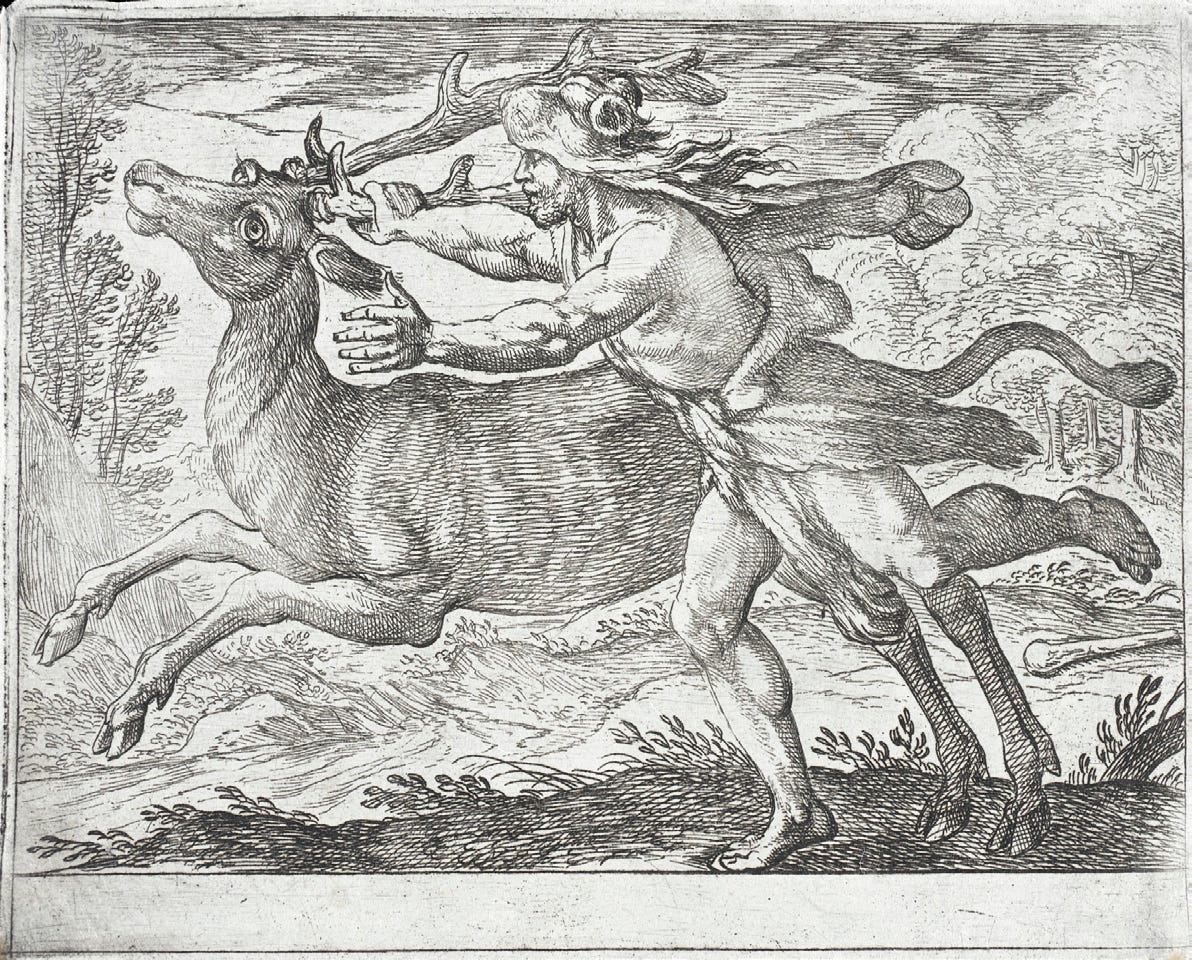Hercules and the Hind of Mount Cerynea, Antonia Tempesta
The Ceryneian Hind
One of Hercules’ most elusive labors was to capture the Ceryneian Hind—an animal said to have been nourished with ambrosia by Artemis herself. A creature sacred to the goddess. Eurystheus, who set Hercules’ tasks, hoped this one would seal his fate. Surely, Artemis would destroy any mortal who dared touch her cherished hind.
Indeed, Artemis did catch Hercules in the act. But fate, as often in myth, had its own plans. Like Hercules, Artemis too was an illegitimate child of Zeus and had tasted Hera’s bitterness. Upon hearing Hercules' explanation—that he meant no harm and intended to release the animal—she let him go, satisfied.
Deer, as it happens, are among the most enthusiastic eaters of Amanita muscaria. I used to forage for these mushrooms in the Waterleidingduinen near Amsterdam, but it was nearly impossible to outcompete the local deer colonies.
For those interested in shamanic exercises: the challenge of touching a deer—touch-a-deer, if you will—is one of the finest tests of inner stillness. A true mental and physical yoga. I once managed to approach a deer within a single meter. A small but profound indicator that my inner quietude was making progress.
One of the most fascinating psychedelic tales from the Middle East—besides Little Red Riding Hood and the Bible—is the story of Shahmaran, known in the 1001 Nights as Jemlia, Sultan of the Underground.
While there’s no definitive proof that Amanita muscaria plays a role in the story, there are curious elements that make one wonder. In arid regions, after all, the bottom of a well might be one of the few places where mushrooms grow. And what to make of a hidden world beneath the surface, filled with pale snakes?
The tale begins with a traveller named Tasmasp—or Camsap. Abandoned by his companions, he ends up at the bottom of a well while gathering honey. There, among the snakes, he meets Shahmaran—a beautiful woman with the lower body of a serpent.
She welcomes him, and they spend years together, during which she shares profound wisdom about the origins and fate of humankind.
They fall in love. But eventually, the man longs to return to the surface.
Handcrafted Turkish mosaic plate from Mersin
Shahmeran, the Serpent of Secrets
At first, Shahmeran did not want Tasmasp to leave. But eventually, she relented—on one condition: he must never speak of her to anyone. When Tasmasp returned to the world above, he found the Sultan gravely ill. The only cure, so the Sultan claimed, lay in Shahmeran’s flesh. He ordered the people to find her—or anyone who knew of her whereabouts.
They turned to the public baths, where the water, enchanted by ancient knowledge, would reveal those who had been in contact with Shahmeran: their skin would turn to scales. Tasmasp entered the baths, and the truth shimmered on his skin for all to see.
He was seized and forced to reveal her hiding place. The Sultan's men found Shahmeran. Before her execution, she spoke:
Eat my serpent flesh, and you shall gain knowledge and healing.
Eat my human flesh, and you shall perish.
The Sultan consumed her serpent flesh. Tasmasp, tormented by guilt, ate her human flesh instead.
But fate had not yet spoken its final word. The human flesh had been poisoned. The Sultan and his court perished. Tasmasp survived—and with him, all of Shahmeran’s knowledge. Thus her wisdom lived on, through the one who had betrayed her.
There is a curious resonance with the goddess Aphrodite. Herodotus, in his Histories, recounts a tale of a half-human, half-serpent woman who bore Heracles three sons. This story appears in Book IV, where he describes the customs of the Scythians (Herodotus, 1996: 219). The parallel suggests a shared archetype: the serpent-woman as guardian of wisdom and initiator of heroes.
In Anatolian folklore, Shahmeran becomes this very figure—benevolent, luminous, and intimately linked to healing. In some regions, it is said that Lokman Hekim, the mythic physician, was taught by Shahmeran herself (Öz, 1994: 24).
She is considered the keeper of the secret of longevity and immortality—her benevolence so profound that her image is still painted on the bedroom walls of young women in eastern and southeastern Anatolia.
Apparently, the goddess Aphrodite—or perhaps her Sarmatian counterpart, Argimpasa, a chthonic deity with serpents in place of legs—represents the primordial waters. Her epithet Apatura (Apa-tura) has been translated as:
The goddess who overcomes the waters.
Now, isn’t it fascinating that the name ALPHA ROD ITE visually echoes the shape of a mushroom?
A Rod
ITE (Earth)
It’s a mushroom, ladies and gentlemen.
And whereas Western fairy tales tend to associate mushrooms with toads, in Eastern traditions, it may well be the snake—not the toad—that serves as the symbolic gatekeeper of the fungal mystery.
Think, for a moment, of Heraclitus. His “snakey field distortions” flickering like lightning—what else was that, if not a trip report?






